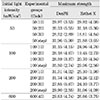1. Buonocore MG. A simple method of increasing the adhesion of acrylic materials to enamel surfaces. J Dent Res. 1955. 34:849–853.

2. Harrington E, Wilson HJ, Shortall AC. Light-activated restorative materials: a method of determining effective radiation times. J Oral Rehabil. 1996. 23(3):210–218.

3. Silikas N, Eliades G, Watts DC. Light intensity effects on resin-composite degree of conversion and shrinkage strain. Dent Mater. 2000. 16(4):292–296.

4. Sakaguchi RL, Sasik CT, Bunczak MA, Douglas WH. Strain gauge method for measuring polymerization contraction of composite restoratives. J Dent. 1991. 19(5):312–326.

5. Mehl A, Hickel R, Kunzelmann KH. Physical properties and gap formation of light-cured composites with and without 'soft-start polymerization'. J Dent. 1997. 25(3-4):321–330.

6. Goracci G, Mori G, Casa de'Martinis L. Curing light intensity and marginal leakage of resin composite restorations. Quint Int. 1996. 27:355–362.
7. Suh BI, Cripe CA, Yin R. Light intensity and exposure time effects on light cured composites. J Dent Res. 1998. 77(Special issue B):Abst. No. #73.
8. Dennison JB, Yaman P, Seir R, Hamilton JC. Effect of variable light intensity on composite shrinkage. J Prosthet Dent. 2000. 84(5):499–505.

9. Fan PL, Wozniak WT, Reyes WD, Stanford JW. Irradiance of visible light-curing units and voltage variation effects. J Am Dent Assoc. 1987. 115(3):442–445.

10. Feilzer AJ, Dooren LH, de Gee AJ, Davidson CL. Influence of light intensity on polymerization shrinkage and integrity of restorative-cavity interface. Eur J Oral Sci. 1995. 103(5):322–326.

11. Unterbrink GL, Muessner R. Influence of light intensity on two restorative systems. J Dent. 1995. 23(3):183–189.

12. Peutzfeldt A, Sahafi A, Asmussen E. Characterization of resin composites polymerized with plasma arc curing units. Dent Mater. 2000. 16(5):330–336.

13. Stritikus J, Owens B. An in vitro study of microleakage of occlusal composite restorations polymerized by a conventional curing light and a PAC curing light. J Clin Pediatr Dent. 2000. 24(3):221–227.
14. Park SM, Shin DH. Microhardness and microleakage of composite resin according to the change of curing light intensity. J Korean Acad Conserv Dent. 2001. 26(5):363–371.
15. Yap AU, Seneviratne C. Influence of light energy density on effectiveness of composite cure. Oper Dent. 2001. 26(5):460–466.
16. Uno S, Asmussen E. Marginal adaptation of a restorative resin polymerized at reduced rate. Scand J Dent Res. 1991. 99:440–444.

17. Burgess JO, DeGoes M, Walker R, Ripps AH. An evaluation of four light-curing units comparing soft and hard curing. Pract Periodontics Aesthet Dent. 1999. 11(1):125–133.
18. Koran P, Kurschner R. Effect of sequential versus continuous irradiation of a light-cured resin composite on shrinkage, viscosity, adhesion, and degree of polymerization. Am J Dent. 1998. 11(1):17–22.
19. Yap AU, Ng SC, Siow KS. Soft-start polymerization: influence on effectiveness of cure and post-gel shrinkage. Oper Dent. 2001. 26(3):260–266.
20. Yap AU, Soh MS, Siow KS. POst-gel shrinkage with pulse activation and soft-start polymerization. Oper Dent. 2002. 27(1):81–87.
21. Friedl KH, Schmalz G, Hiller KA, Markl A. Marginal adaption of Class V restorations with and without "soft-start polymerization". Oper Dent. 2000. 25(1):26–32.
22. Price RB, Bannerman RA, Rizkalla AS, Hall GC. Effect of stepped vs. continuous light curing exposure on bond strengths to dentin. Am J Dent. 2000. 13(3):123–128.
23. Asmussen E, Peutzfeldt A. Influence of pulse-delay curing on softening of polymer structures. J Dent Res. 2001. 80(6):1570–1573.

24. St-Georges AJ, Swift EJ Jr, Thompson JY, Heymann HO. Curing light intensity effects on wear resistance of two resin composites. Oper Dent. 2002. 27(4):410–417.
25. Bouschlicher MR, Rueggeberg FA, Boyer DB. Effect of stepped light intensity on polymerization force and conversion in a photoactivated composite. J Esthet Dent. 2000. 12(1):23–32.

26. Lim BS, Ferracane JL, Sakaguchi RL, Condon JR. Reduction of polymerization contraction stress for dental composites by two-step light-activation. Dent Mater. 2002. 18(6):436–444.

27. Obici AC, Sinhoreti MA, de Goes MF, Consani S, Sobrinho LC. Effect of the photo-activation method on polymerization shrinkage of restorative composites. Oper Dent. 2002. 27(2):192–198.
28. Sakaguchi RL, Berge HX. Reduced light energy density decreases post-gel contraction while maintaining degree of conversion in composites. J Dent. 1998. 26(8):695–700.

29. Yoshikawa T, Burrow MF, Tagami J. A light curing method for improving marginal sealing and cavity wall adaptation of resin composite restorations. Dent Mater. 2001. 17(4):359–366.











 PDF
PDF ePub
ePub Citation
Citation Print
Print












 XML Download
XML Download